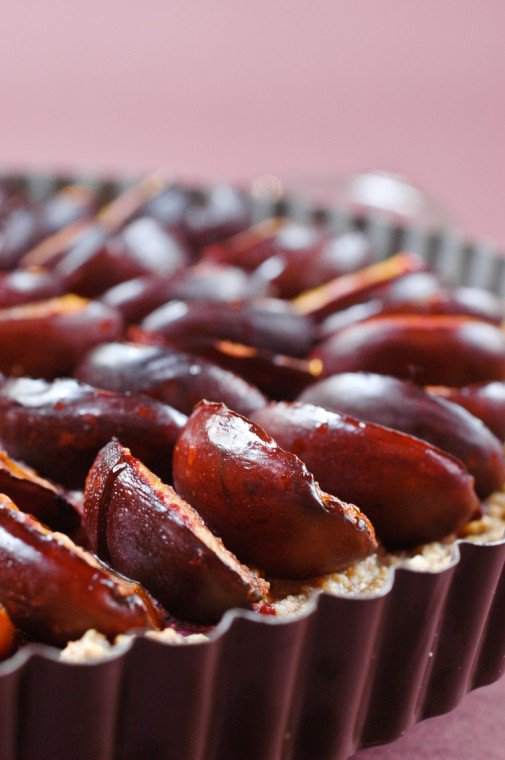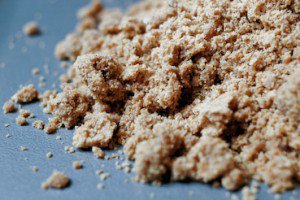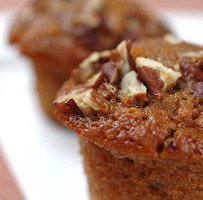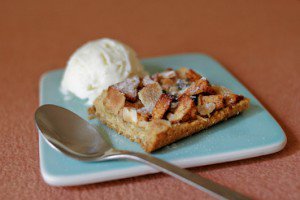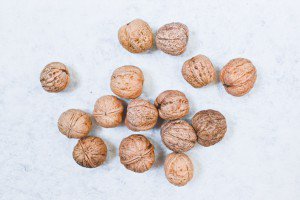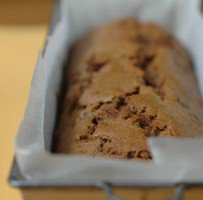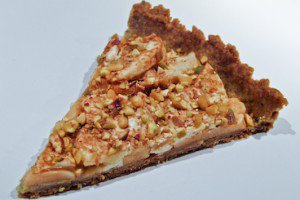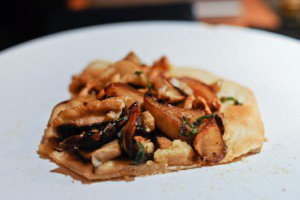I love plums. I love that they are small and that you can rinse a few of them at a time, whirling them in your hand like Baoding balls. I love that they come in sundry shapes and colors to match your outfit, I love that they have a pit that you can spit out into the sink, and I love that they grow on trees under which you can stand, look up, and feel like all is right in the world. I love even the name, plum, how it rolls off the tip of your tongue, and the French version of it, prune, which makes your lips purse as if you’d eaten an underripe specimen.
I have to say, though, that a sunny September day a few years ago very nearly ruined plums for me: this was the day that Maxence and I stumbled upon a pick-your-own farm in Alsace. We spent a few euphoric hours filling buckets of mirabelles (tiny, goldenrod plums with dark orange freckles) and quetsches (egg-shaped, purple-blue plums, which resemble damsons but are much sweeter) and gorging on them as we went (the sign said we could), after a quick brushing off of the powdery white veil called bloom (pruine in French) — a sure sign of a plum’s freshness, since it vanishes shortly after the fruit has been picked.
I have since then found it difficult to procure the kind of fragrant, tree-ripened plums that would live up to the memory: the Gérardmer market has crates of them of course, but produce shops in Paris tend to offer plums that have been picked a touch early so they’ll travel without bruising, and anyone with half a taste bud knows that plums were not meant to end their ripening on a kitchen counter.
But, if you’re bold enough to ask the merchant for a taste, and bold enough to say, “Um, maybe not,” when the plum is not to your liking (if you develop a friendly relationship with your produce guy, boldness is not required; a simple smile will do), this will guarantee that only ripe, sweet, juicy plums pass your threshold. And when that happens, perhaps you can bake a tart to congratulate yourself.
The following is a simple variation on my mother’s classic tarte aux quetsches: instead of pouring an egg and cream custard over the plums, I lined the tart shell with crème de noix, the same mixture of walnuts, eggs, sugar, and crème fraîche that is used in walnut tarts in the Périgord. I deliberately used little sugar in the walnut cream, so a slight edge of bitterness could be heard through the sweetness of the sandy crust and caramelized plums. The use of unrefined cane sugar added a faintly earthy note to the ensemble, making it a most appropriate treat for a late summer or fall day.

Have you tried this? Share your pics on Instagram!
Please tag your pictures with #cnzrecipes. I'll share my favorites!
Ingredients
- 75 grams (1/3 cup plus 1 tablespoon) sugar (I use unrefined cane sugar, but regular white sugar is fine)
- 150 grams flour -- if you use American all-purpose flour, use 1 cup plus 2 tablespoons
- 75 grams butter (I use salted, but you can use unsalted and add a pinch of salt) -- if you use regular American butter (which has less butterfat than European butter), use 7 tablespoons
- Ice-cold water or milk
- 135 grams (1 1/4 cups) shelled walnut halves
- 2 tablespoons sugar (I use unrefined cane sugar; regular white sugar is fine, honey would be lovely, too)
- 1 egg
- 3 tablespoons crème fraîche (substitute sour cream)
- Optional flavoring: 1 teaspoon pure vanilla extract, or 1 teaspoon plum or walnut liqueur, or 1 teaspoon dark rum
- 700 grams (1 1/2 pounds) ripe quetsche plums (substitute any other variety of plum)
Instructions
- Preheat the oven to 180°C (350°F). Grease a 10-inch tart pan with butter and set aside.
- Prepare the pâte sablée. In the bowl of a mixer or blender, combine the sugar and flour. Add the butter and process in short pulses until the mixture resembles coarse meal. (Alternatively, rub the butter into the dry ingredients by hand with the tips of your fingers or a wire pastry blender.)
- Add a tablespoon of water or milk and mix again, in short pulses, until it is absorbed. The dough should still be crumbly, but it should clump if you gently squeeze a handful in your hand. If it doesn't, add a little more water -- teaspoon by teaspoon -- and give the dough a few more pulses until it reaches the desired consistency.
- Pour the mixture evenly into the prepared tart pan. Using the heels of your hands and your fingers, press on the dough gently to form a thin layer, covering the surface of the pan and creating a rim all around. Don't worry if the dough feels a little dry, this is normal. (You can prepare the dough up to a day ahead: cover with plastic wrap and refrigerate.) Bake for 15 minutes, until lightly golden.
- While the crust par-bakes, prepare the filling. Combine the walnuts and sugar in the bowl of your mixer, and grind to a coarse powder. Add the egg, crème fraîche, and flavoring if using, and mix again. (You can prepare the walnut cream up to a day ahead: transfer to an airtight container, refrigerate, and bring to room temperature before using.)
- Rinse and dry the plums, cut them in halves, and discard the stones.
- Remove the pan from the oven (leave the heat on), and let cool slightly.
- Spread walnut cream evenly over the tart shell, and arrange the plums on top in a circular pattern starting from the outside.
- Return to the oven for 30 minutes, until the plums are cooked through and the walnut cream is set. Transfer to a rack to cool completely before serving. The tart is best served on the day it is made, but the leftovers will keep until the next day; cover with foil, refrigerate, and bring to room temperature before eating.
This post was first published in October 2006 and updated in July 2016.


